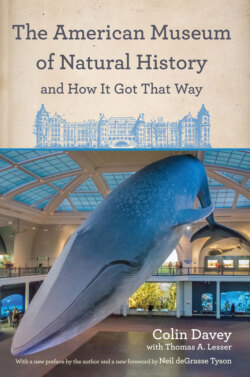Читать книгу The American Museum of Natural History and How It Got That Way - Colin Davey - Страница 9
На сайте Литреса книга снята с продажи.
ОглавлениеForeword
Kermit Roosevelt III
The American Museum of Natural History is one of our nation’s most iconic institutions. It’s a staple visit for New York school-children or families, but anyone growing up on the East Coast is likely to have visited. I spent my childhood in Washington, D.C., but still remember wandering through the exhibits. (The dinosaurs are the classic draw for youngsters, but what sticks in my mind are the gemstones in the Hall of Minerals.) As a Philadelphian, a few hundred miles closer, I’ve had the chance to watch my own children run around under the whale suspended in the Hall of Ocean Life.
The Museum has made its way into popular culture, featured in a number of movies and even a pop song (“Laser Show,” by Fountains of Wayne, is about the Hayden Planetarium). Perhaps most famously, J. D. Salinger’s alienated teenager Holden Caulfield spends a fair amount of The Catcher in the Rye reflecting on his visits to the Museum. He’s comforted by the permanence of the exhibits: Nothing changes, no matter how many times you go back.
Holden was not alone in that sentiment. “Nothing changes” is what the Museum’s president said in 1968, upon unearthing the time capsule buried in 1874 and reading the newspaper headlines it contained. His reaction was understandable. The capsule was buried during the post–Civil War Reconstruction; by digging it up during the Second Reconstruction of the civil rights era, he had caught one of history’s rhymes. But it was wrong. Things do change, as this book reveals. The Museum has grown from a single Victorian Gothic building to a vast (and sometimes bewildering) set of spaces; its location, what its geologist called a “rugged, disconsolate tract of ground,” is now the heart of the Upper West Side. The Museum has a Twitter account and a Facebook page. The blue whale was updated for greater accuracy; the original Hayden Planetarium was demolished and replaced. Not even the number of planets is stable. Tracing the path of the Museum’s development is fascinating in its own right. But can the story of this institution tell us something more?
Ontogeny recapitulates phylogeny. It’s a phrase to warm the heart of a natural history enthusiast. It means that the development of an individual organism repeats the stages of evolution of the species. As a biological hypothesis, it’s not quite true, but the idea has application to other fields. Individual athletes, artists, and students, for example, often develop their skills in a manner that parallels the historical development of their discipline.
So too, in a way, with natural history. The Museum has changed, and the world around it, and it is not fanciful to see in the Museum’s history some parallels to our own relationship with the natural world. It starts with mastering the environment, making the rough and inhospitable ground into a place fit for our habitation. It continues with expansion and acquisition: We take, we build, we display. In 1915, the Museum’s president pronounced that its growing collections had placed it “in the position of a family that has outgrown its home.” He wanted new buildings, and he got them. But at a certain point there is no more room. Since the dedication of the Roosevelt Memorial in 1936, little has been added. Instead, the Museum has renovated, modernized, and renewed its existing spaces.
That is a different kind of change, and its implementation requires a different vision, one focused not on expansion and acquisition but on conservation and improvement. It requires that we change—which, inevitably, we do. (In the end, Holden can’t go into the Museum for that reason: Its stability will confront him with how much he has changed.) Our ideas of productive engagement with the natural world change; we see ourselves less as conquerors and more as custodians. “The nation behaves well,” said Theodore Roosevelt, “if it treats the natural resources as assets which it must turn over to the next generation increased, and not impaired, in value.” Like museums, he saw natural spaces as resources for everyone, places all could go to learn, to find themselves, or to forge new identities, as he had. (Of the Museum itself, he told his cousin Franklin, “You can learn more about nature and life in the Museum than in all the books and schools in the world.”)
There is, though, one important way in which the analogy fails. We can live without museums; we can neglect them, let them fall to pieces, and still go on. We cannot live without the environment, for the simple reason that we live within it. In that sense we are less the caretakers of the natural world than its guests. I think often these days of a story I heard about an octopus that discovered it could rearrange the contents of its tank. It shifted around some rocks; it moved a mirror. Then it pulled out the aerator, and I imagine it must have felt pretty smart for a few hours, as the water turned to poison around it.
Preservation, it turns out, requires change: change in ourselves, change in our understanding of our place in the world. We need an attitude not of conquest or idle tinkering but of respect, even awe. How can we promote that? Museums are surely part of the answer, which suggests that perhaps we cannot live without them after all. What the Museum has done, in different ways, through the different stages of its life, is to feed the human sense of wonder at the universe. And that is the one thing that must remain constant if we are to endure.
Kermit Roosevelt is a professor of constitutional law at the University of Pennsylvania Law School and the author of the novels In the Shadow of the Law and Allegiance.
